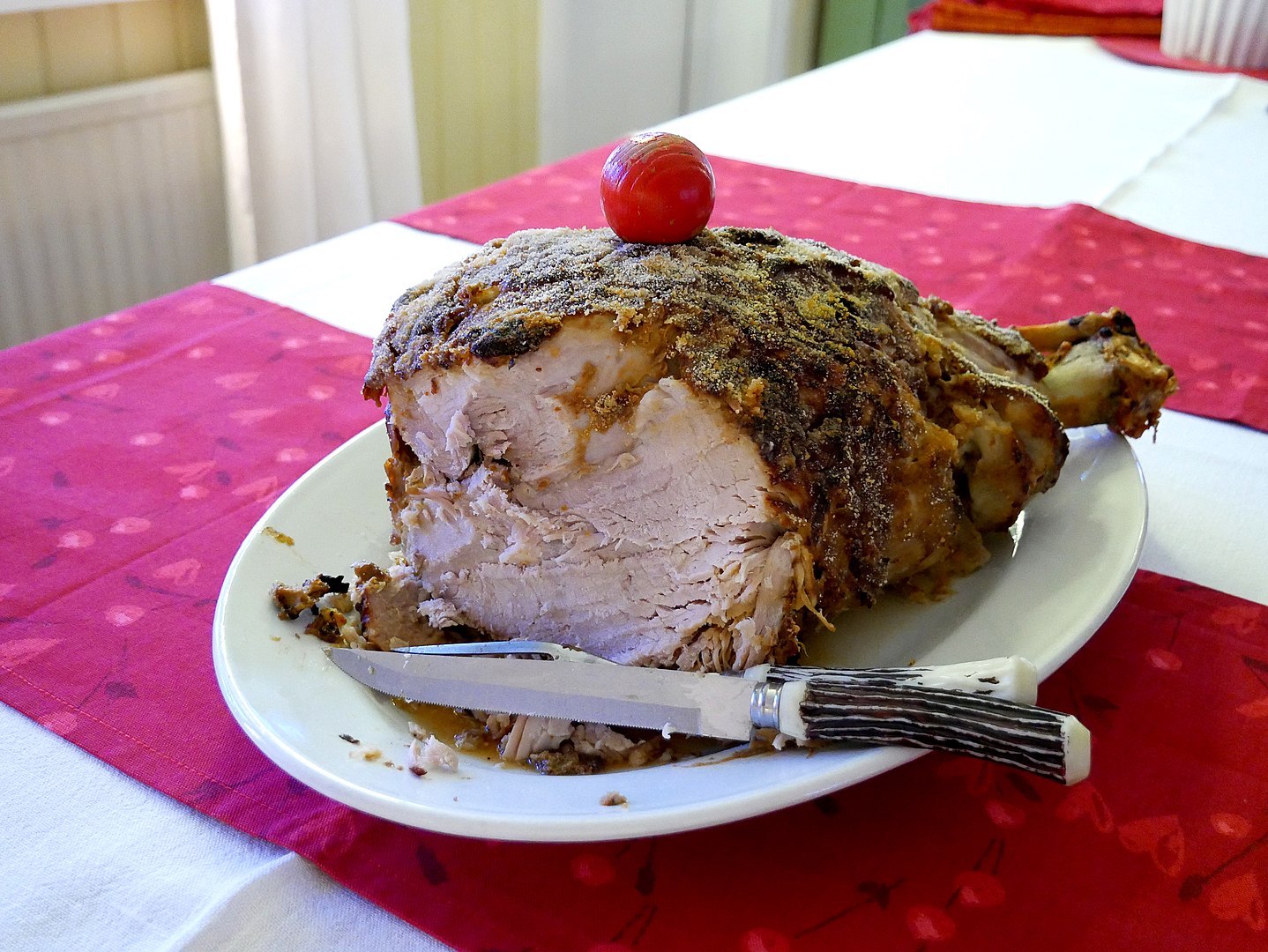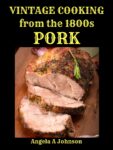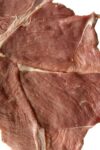
How to Cure and Cook Ham
Ham was an important food as it could be cured and preserved for the winter months. It was heavily salted, so it needed to be soaked many hours before cooking to remove most of the salt taste.
INFORMATION BELOW FROM 1800s COOKBOOKS
TO CURE HAMS
To make good hams, the pork must be of the best quality. No animal tastes so much of its food as the pig. For one hundred pounds of fine pork, take seven pounds of coarse salt, five pounds of brown sugar, two ounces of saltpeter,* half an ounce of pearl ash,* and four gallons of water.
Boil all together and skim the pickle when cold. Pour it on the meat. Let hams remain in the pickling-tub eight weeks. Before it is smoked, hang it up and dry it two or three days. Previous to sewing the hams in cases, rub them all over with ground black pepper.
Smoke it well for a fortnight,* hanging it high above the fire with the large end downward. The fire in the smoke-house should be steadily kept up all the time. Hickory or oak is the best wood for this purpose. On no account use pine, cedar, spruce, or hemlock. They will communicate to the meat a strong taste of turpentine, and render it uneatable. A fire made of corn-cobs is excellent for smoking meat and they should be saved for that purpose.
When the meat is smoked, rub it all over again with ground pepper to prevent insects and sew up all the pieces in new cotton cloths, coarse and thick, and then white-wash* them. If they are to go to sea, pack the hams in boxes of powdered charcoal for a long voyage. For a short one, barrels of wood-ashes will do.
*saltpeter – potassium nitrate, an early food preservative, but now rarely used.
*pearl ash – the white powder that remains when potash is baked in a kiln.
*fortnight – a period of two weeks.
*white-wash – a type of paint made from slaked lime or chalk calcium carbonate.
BOILED HAM
Soak a fine ham from early in the evening till near bed-time, put it into warm water and change that water about ten or eleven o’clock. Wash and brush it well in the morning and trim it so as to look nicely all over. Lay at the bottom of the ham-boiler a bed of nice fresh hay, which will greatly improve the flavor. Let the hock bone be sawed off short. A long shank bone looks very awkward.
Place the ham upon the hay—pour in plenty of cold water, and keep it simmering very slowly an hour before you allow it to boil. Then increase the heat gradually and keep the ham boiling steadily for four, five, or six hours, according to its size and age. An old ham requires more soaking and boiling than a new one. Skim it frequently after the boiling begins. It will be much improved by transferring it to a spit, (having taken off the whole skin,) and roasting the ham, for the last two or three hours, basting it with its own essence. Save the skin to cover the cold ham, and keep it fresh. Before it goes to table, cover the ham with grated bread-crumbs, sifted on so as to form a slight crust.
If the ham is to be eaten cold and is intended for company, brush it all over with beaten yolk of egg. Then dredge on sufficient grated crumbs to form a crust half an inch thick, and finish by going all over it with cream. Set it to brown in an oven or put it on the spit of a roaster. When cold, this glazing will be found surpassingly fine. Carve a ham in very thin slices—if cut thick, they have not the same taste.
BAKED HAM
For baking, take a small ham or part of a large one, trimmed and made of good shape, cutting away whatever looks unsightly. Have the bone sawed off at the knuckle, or end of the hock. The evening previous to cooking, lay the ham to soak in a large pan of hot water. At bed-time pour off the water, and renew it. Keep it close covered all night. In the morning, wash and brush it well. Make a coarse paste of flour mixed with water only, and roll it out about an inch thick. Line a clean iron bake-oven with this and put in the ham, reserving enough of the paste to cover the top.
Pour in a very little water, merely sufficient to keep the ham from burning. Put on the lid of paste and having wet the edges, slightly press them together, so as to unite closely the top and bottom crust. Bake it over a steady fire, from four to five or six hours, or more, according to its size. When done, skim the gravy, remove the paste, (which is of no further use,) and take off the skin of the ham. Dredge it all over with finely grated bread-crumbs before it goes to table. A ham can scarcely be cooked too much or too slow. A ham of the smallest size will require at least four hours baking or boiling, even after it has been all night in soak. Save the skin whole to cover the cold ham when it is put away in the pantry.
When a cooked ham is nearly all used up, take what remains, cut it all off from the bone, and stew the bits in a little water till they are all to rags. You will find the essence an improvement to gravies, strained from the fragments.
DISGUISED HAM
Scrape or grate a pound of cold boiled ham, twice as much lean as fat. Season it slightly with pepper and a little powdered mace or nutmeg. Beat the yolks only of three eggs, and mix with them the ham. Spread the mixture thickly over slices of very nice toast, with the crust pared off, and the toast buttered while hot. Brush it slightly on the surface with white of egg, and then brown it with a red hot shovel or salamander.* This is a nice breakfast dish.
*salamander – a circular iron plate to which is attached a long handle. It is made red hot in the fire and held over the article to be browned, being careful not to have it touch.
HAM CAKE
This should be made the day before it is wanted. Take the remains of a cold ham. Cut it into small bits, and pound it well (fat and lean together) in a marble mortar, adding some butter and grated nutmeg, or a little cream, sufficient to moisten it throughout. Fill a mold with the mixture, and set it for half an hour into a moderate oven.* When ready for use, set the mold for a few minutes into hot water and then turn out the ham cake on a dish. Cover the surface all over with a coating of beaten white of egg. Before it is quite dry, decorate it with capers, or pickled nasturtium* seeds, arranged in a pattern. Send small bread rolls to the supper table with the ham cake.
*moderate oven – a moderate oven is about 350-400 degrees Fahrenheit.
*nasturtium – a flower whose seeds can be pickled and used as a substitute for capers.
POTTED HAM
Take some cold ham, slice it, and mince it small, fat and lean together. Then pound it in a mortar, seasoning it as you proceed with cayenne pepper, powdered mace, and powdered nutmeg. Then fill a large deep pan with the mixture and set it in an oven for half an hour. Afterwards, pack it down hard in a stone jar, and fill up the jar with lard. Cover it close and paste down a thick paper over the jar. If sufficiently seasoned, it will keep well in winter, and is convenient for sandwiches, or on the tea-table. A jar of this will be found useful to travelers in remote places.
=================================================
Writing this post on ham reminded me of canned SPAM. I discovered SPAM was first produced in 1937.
I was also amazed to see several varieties. There are Classic, Garlic, Low Sodium, Hickory Smoke, Bacon, and White Turkey,
=================================================
Do you like eating ham or are you a fan of SPAM? Leave a comment below and please share this post.
=================================================
 VINTAGE COOKING from the 1800s ~ PORK
VINTAGE COOKING from the 1800s ~ PORK
by Angela A Johnson
Journey back into the 1800s and discover how people prepared, cooked, and preserved pork, making use of the whole animal. With no electrical refrigeration or modern conveniences, it was a time of thriftiness, resourcefulness, and “making do.”
Recipes Include Pig Feet Relish, German Roast Pork, Boiled Bacon and Cabbages, Bologna Sausage, Pork Apple Pot-Pie, Pork and Peas Pudding, Pork Stew, Baked Pork and Beans, Italian Pork and more.
Available from these online Retailers:
Amazon, Kobo, Apple, Barnes&Noble, Scribd, 24 Symbols, Playster, Angues & Robertson, Mondadori Store, and more.
Also available as Regular Print and Large Print on Amazon.
=================================================

